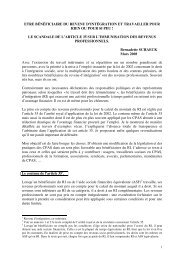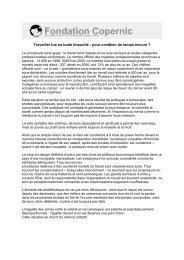Awra Amba RJ 300612 EN - Contacter un comité local d'Attac
Awra Amba RJ 300612 EN - Contacter un comité local d'Attac
Awra Amba RJ 300612 EN - Contacter un comité local d'Attac
You also want an ePaper? Increase the reach of your titles
YUMPU automatically turns print PDFs into web optimized ePapers that Google loves.
4. Social organisation<br />
the table: Question 21 in Annex), tef and beans (boloqie): see Table 4. Maize (or sorghum) has a<br />
much higher yield per hectare than the other crops. The average yield – for all crops – is higher by<br />
14 % than the Ethiopian yield, which is 13.3 q/ha, and by 26 % than the regional yield, which is<br />
12.0 q/ha (Ya08/102).<br />
The comm<strong>un</strong>ity owned 18 zebus, 1 donkey, 1 mule and 44 hens in 2005 (At05/39), and in 2008 16<br />
male zebus, 11 female ones, 1 donkey and 4 sheep among others (Ya08/120), which were not kept<br />
close to the houses according to At05/39, or which stayed in their stables most of the time and are<br />
fed here according to Crespo (2012). Therefore, it seems the livestock increased in three years. A<br />
barn has been financed by the USA (Jo10b/7).<br />
The peasants plough their land with a wood mouldboard plough drawn by two zebus (Picture 6 and<br />
Picture 7). Surprisingly, several fields have not been cleared of stones, as the Picture 7 shows, which<br />
should considerably increase the work involved in ploughing and maintenance, and greatly reduce<br />
their productivity. The cooperative considers clearing the stones would take too much work<br />
according to Jo10b/8, or it is a usual way to combat rain and wind erosion according to Crespo<br />
(2012). Finally, <strong>un</strong>like the rest of Ethiopia, <strong>Awra</strong> <strong>Amba</strong> inhabitants use saws and not only axes to cut<br />
eucalyptus for timber or firewood.<br />
Picture 6:<br />
Ploughman with his plough and his yoke leaving for fields.<br />
Picture 7: Ploughing, in April 2010.<br />
As they cannot live on agriculture alone, given the poverty and the scarcity of the soil, they have<br />
45 / 85

















